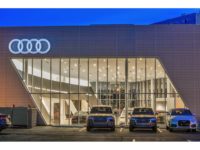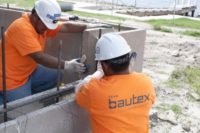As regulations and demands increase for energy efficiency in all facets of modern society, the building industry has found itself in a balancing act when it comes to the exterior. Architects are challenged to find the center ground between admitting natural light to improve the occupant experience and effectively managing a building’s lighting, heating and cooling energy consumption.
While natural to focus on the glazing material itself since it comprises a large portion of the curtain wall and window area, an important variable is also the framing. Curtain wall and window framing establishes the total possible area of unobstructed glazing, provides support for high-efficiency glass units and can improve thermal performance. As evidenced in the 804 Carnegie Center in Princeton, N.J., today’s progressive framing systems can even go so far as to help achieve equilibrium between light transfer and energy outcomes.
Setting the Scene for Green Building Initiatives
Designers for the three-story mixed-use facility, 804 Carnegie Center, had one goal: to create a new architectural direction for future developments in the area. The design intention was to pair cutting-edge technology with high-performance materials to create an ultra-green facility.
One of the building’s most noticeable features is a smooth, monolithic glass curtain wall facing due south. Jacobs Engineering Group used a silicone glazed steel curtain wall framing system to create the highly visible, seamless glass box on the trading floor wall. It enables expansive spans of glass while supporting the building’s goals for energy-efficiency, striking a challenging balance. The design team also used the curtain wall system to surround the building’s main entrance.
Strengthening Opportunity
The silicone glazed steel curtain wall framing system installed in 804 Carnegie Center utilizes modern cold roll-formed and laser welded steel framing methodologies that capitalize on steel’s obvious strength over more conventional materials like aluminum. Steel has a Modulus of Elasticity nearly three times that of aluminum (2.9 x 107 vs. 10.0 x 107psi). When its strength is paired with new forming methodologies, the outcome is slender frame profiles that enable greater allowable free spans of glass than its material cousin without the need for reinforcing or more frequent connections to the building structure.
In 804 Carnegie Center, this resulted in free spans of glazing to bring daylight deep into the interior floorplate and facilitate views to the outside. Depending on project criteria, steel curtain walls using continuous steel back mullions can support up to 40 feet spans in a single member without splicing. This, of course, is dependent on variables such as center-to-center location of vertical members, span length and structural loads.
Steel’s strength also translates to smaller system shapes without decreasing performance. For example, a steel back mullion can be 50 percent narrower than an aluminum back mullion with the same cross-sectional properties and still meet the same deflection criteria. In turn, this translates to larger, uninterrupted views of the outside environment, permitting a greater percentage of light to enter interior occupied spaces.
Supporting High-Efficiency Glass Units
Due to steel’s strength, the silicone glazed steel curtain wall framing system in 804 Carnegie Center also supports high-performance glazing. This helps provide increased access to daylight while combatting the heat-exchange dilemma with marginal effects on the design intent.
In looking in detail at how the material melds strength with energy efficiency, steel can provide the necessary support for heavy triple-glazed IGU’s, and/or for a wide variety of glass thicknesses, whereas most aluminum glazing systems can only handle a single glazing infill thickness. This is paramount as traditional framing materials may not be able to support the required loads associated with high-performance glazing, simply due to its size, thickness, and/or weight. Design teams may be forced to reduce the glass lite size and modify free span distances. This results in more framing, not less, which can detract from the intended design.
It is important to note that while steel curtain wall and window systems can support high-efficiency glass units, it is still crucial they account for changing sun angles and solar heat gain. Incorporating shading devices—such as exterior mounted sunshades in the 804 Carnegie Center—can help lessen direct solar transmittance through the glass. This is key since even strategically positioned curtain wall assemblies are subject to direct sunlight during certain hours of the day.
Creating a Sound, Sleek Building Envelope
804 Carnegie Center’s steel-based curtain wall system is also particularly useful for meeting the building’s green guidelines without compromising on appearance. Installed by Josloff Industries, LLC, the versatile system uses toggles to hold the extruded aluminum cassettes, which are structurally silicone sealed to the glass and steel framing. The structural silicone glazing transfers wind loads through the glass and cassettes into the supporting steel curtain wall. With no exterior caps and minimal back mullions, the resulting system allows for uninterrupted exterior sightlines and the desired smooth glass-to-glass, butt-glazed appearance.
While the sleek system benefits the overall design, it also contributes to a sound building envelope. Steel promotes better U-values in the assembly by eliminating thermal breaks and unnecessary exterior exposed metal. In large part, this is attributed to steel’s thermal conductivity, which is approximately 74 per cent less than aluminum (i.e. approximately 32,707 joule [31 Btus] per hour). This is equivalent to that of thermally broken aluminum frames. Even more importantly, due to the design of steel profiles, some advanced offerings do not require a traditional thermal break. Steel frames without a thermal break require less metal to support the glazing than traditional aluminum frames. This in turn reduces the pathway for heat transfer and offers greater resistance to heat transfer than aluminum systems.
Conclusion
In addition to its high-performance curtain wall and glass assemblies, the 804 Carnegie Center features 10,000 square feet of solar panels, rainwater and daylight harvesting systems, a green roof, two wind turbines and more than 30 electric vehicle charging stations. For its collective approach, the building was awarded LEED Platinum Certification, the most stringent green building certification worldwide, according to lead designers on the project from Jacobs Engineering Group.



